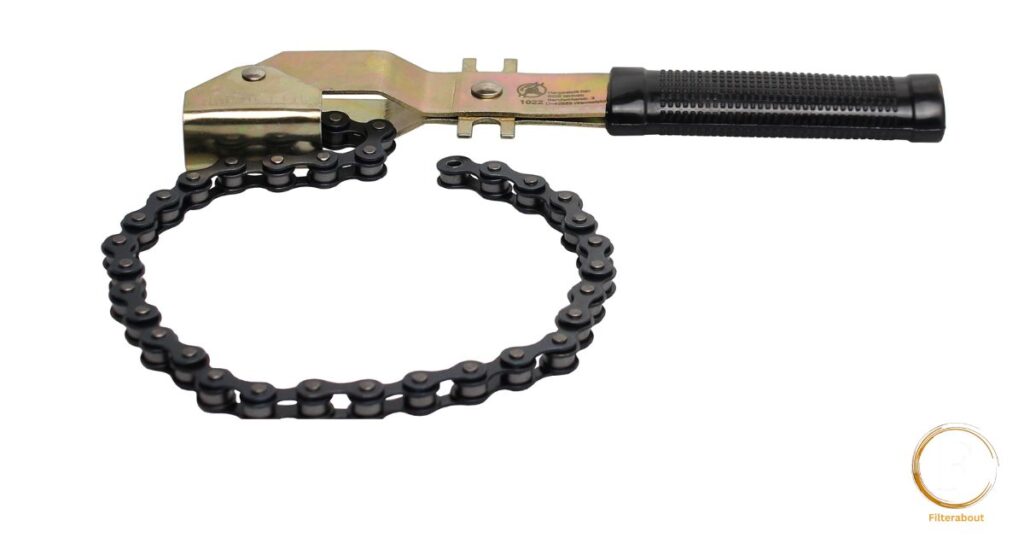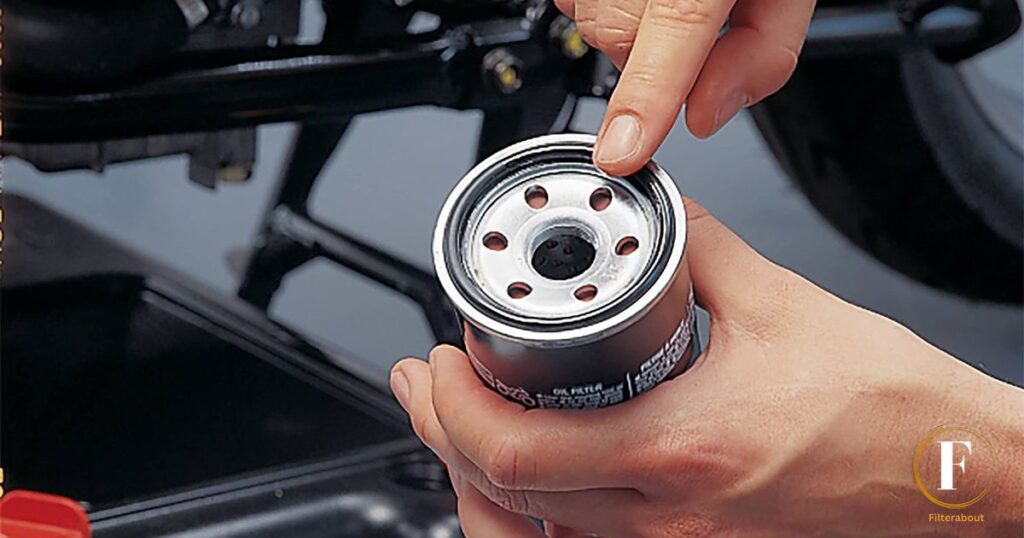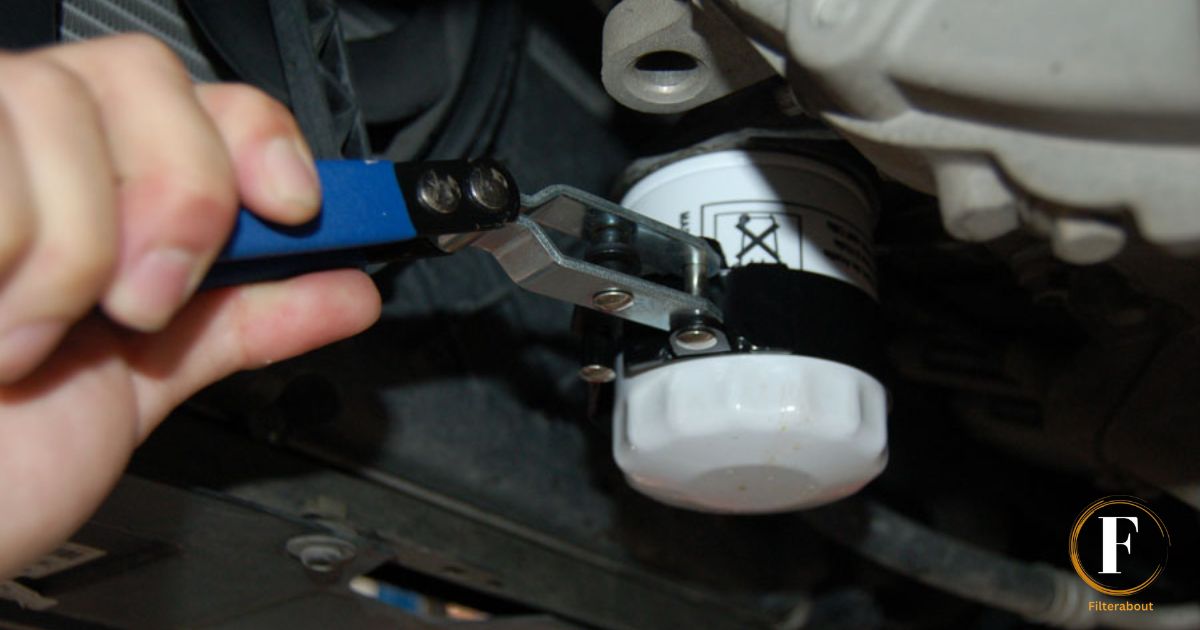Oil filters are removed using oil filter wrenches. It has a specialized design with adjustable grips or bands to fit different oil filter sizes. The wrench helps provide a strong grip on the oil filter housing, allowing for easier and more efficient removal during oil changes.
Wondering how to use oil filter wrench? Start by selecting the correct size wrench that fits your oil filter. Slip the wrench over the oil filter and ensure a tight grip. Once secured turn the wrench counterclockwise to loosen and remove the oil filter effortlessly. Consult your vehicle’s manual for specific instructions on oil filter removal and replacement.
When using an oil filter wrench identify the right size for your oil filter. Place the wrench securely over the oil filter ensuring a snug fit. Continue until the oil filter is loose enough to be removed by hand. Replace it with a new filter tightening it manually. Confirm a snug fit without over-tightening.
Types of Oil Filter Wrenches
The most common types include strap bands and cap-style wrenches. Strap wrenches feature a flexible strap that tightens around the oil filter when force is applied, making them versatile for various sizes. They’re adjustable and useful in tight spaces due to their maneuverability.
Band wrenches work similarly to strap wrenches but use a metal band instead. They often have a ratcheting mechanism allowing for easier handling and increased grip. These are excellent for larger harder-to-reach oil filters and provide a firm hold when removing stubborn oil filters.
Cap-style wrenches resemble a socket and fit over the end of the oil filter. They come in various sizes and are suitable for specific oil filter types. Cap wrenches provide a snug fit minimizing the risk of slippage and damage to the oil filter. This type is popular for its ease of use and ability to provide a strong grip on the oil filter housing.
Cap Style Oil Filter Wrenches
It is are versatile tool designed to easily grip and remove oil filters. With their unique cap-like shape they provide a secure hold and make oil filter changes a breeze. Their adaptable design fits various oil filter sizes making them a must-have for hassle-free maintenance.
Plier Type Oil Filter Wrenches
It is are specialized tools featuring adjustable serrated jaws to grip and remove stubborn oil filters. Their versatile design allows for a secure hold on various oil filter sizes offering flexibility and ease during oil filter changes. With their strong grip and durable construction these wrenches make oil filter removal efficient and straightforward.
Socket Style Oil Filter Wrenches
It is are efficient tools with a socket-like structure designed to fit over oil filters for easy removal. Their hexagonal or square shape provides a secure grip allowing mechanics to swiftly loosen or tighten oil filters during maintenance. These wrenches, available in various sizes, ensure a snug fit and smooth operation for hassle-free oil filter changes.
Heavy Duty Oil Filter Wrench

It features a robust construction often made of durable materials like steel to withstand the high torque required for stubborn or tightly sealed oil filters. The wrench typically has an adjustable design allowing it to fit various oil filter sizes ensuring versatility across different vehicles and equipment.
The adjustable mechanism or serrated teeth on the wrench enable a secure grip around the oil filter providing a reliable hold while you apply force to loosen or tighten it. Its sturdy build and ergonomic handle reduce the risk of slippage or damage to the oil filter during the removal or installation process making routine maintenance tasks more efficient and less strenuous.
For professional mechanics or DIY enthusiasts, investing in a heavy-duty it can streamline oil changes and maintenance procedures, especially on larger vehicles trucks, or industrial machinery. Its durability and adaptability to various oil filter sizes make it a valuable addition to any toolkit ensuring a hassle-free and secure way to manage oil filter replacements with ease.
How to adjust Oil Filter wrench?
It seems you’re looking for additional steps beyond the basic adjustment process for an oil filter wrench. Here’s a more expanded guide that includes further steps.
- Select the Right Size: Choose an adjustable wrench that matches the size of your oil filter or can be adjusted to fit it.
- Locate Adjustment Mechanism: Identify the mechanism for adjusting the wrench size often a knurled wheel or a locking mechanism near the handle.
- Loosen Adjustment: Turn the adjustment mechanism to increase the wrench’s diameter until it fits around the oil filter comfortably but isn’t too loose.
- Secure Adjustment: Once the wrench fits the oil filter firmly tighten the adjustment mechanism to hold the size in place securely.
- Test Fit: Check that the wrench is firmly gripping the oil filter without slipping before applying force.
- Position the Wrench: Ensure the wrench is positioned perpendicular to the oil filter for maximum grip and leverage.
- Apply Even Pressure: When removing or tightening the filter use steady and even pressure to avoid damaging the oil filter or the surrounding components.
These additional steps should help in using the adjusted filter wrench effectively and safely ensuring proper oil filter installation or removal without causing damage.
Chain Oil Filter Wrench

A chain oil filter wrench is a versatile tool designed to easily remove filters from vehicles or machinery. It features a chain loop that wraps around the oil filter providing a secure grip to loosen and remove it with minimal effort. The chain design allows the wrench to fit around oil filters of various sizes making it adaptable for different vehicles including cars, trucks motorcycles and even some industrial equipment.
This tool is popular among mechanics and DIY enthusiasts due to its effectiveness in tackling stubborn filters. The adjustable chain allows for a tight fit around the oil filter housing ensuring a strong grip to break loose oil filters that might otherwise be challenging to remove. Its simplicity and ease of use make it a handy addition to any toolkit offering a reliable solution for oil filter removal without damaging the oil filter or the surrounding components.
To use it you simply adjust the chain to fit the diameter of the oil filter ensuring a snug fit. Then by applying force in the loosening direction typically counterclockwise the chain’s grip on the oil filter allows for easy turning and removal. Its robust construction and ability to handle various oil filter sizes make it a go-to tool for hassle-free oil filter replacements during maintenance or repairs.
How to deal with that stuck Oil Filter?
When faced with a stubborn or stuck oil filter it’s essential to approach it methodically to avoid damaging the oil filter or the engine. Begin by using a wrench or a specialized tool designed for this purpose. Place the wrench securely around the oil filter ensuring a good grip and apply steady even pressure in a counterclockwise direction to loosen it. If the oil filter doesn’t budge try using a bit of force but be cautious not to overtighten and risk damaging the oil filter housing.
If the oil filter remains stuck there are a few tricks you can try. First using a heat gun or hairdryer apply gentle heat to the oil filter’s base. This helps to expand the metal potentially loosening the grip. Be cautious not to overheat the area to avoid causing damage. Additionally tapping the oil filter gently with a rubber mallet or a piece of wood can help to break the seal. Alternating between applying heat and tapping may aid in freeing the stuck oil filter.
If all else fails and the oil filter remains firmly stuck seeking professional assistance from a mechanic or an automotive specialist is advisable. They have the expertise and tools necessary to handle challenging situations like this without causing damage to the vehicle. It’s crucial not to force the issue excessively as it could lead to leaks or structural damage to the engine ultimately causing more significant problems.
How to use Oil filter Wrench Strap Style?

Using a wrench strap style is a straightforward and effective way to remove and replace oil filters on vehicles. To begin locate the oil filter under the hood of your car. Ensure the engine is cool before proceeding. Once you’ve identified the oil filter slide the strap of the filter wrench around the oil filter housing making sure it’s snug and securely in place.
With the strap properly positioned use the handle or ratchet mechanism to tighten the strap around the oil filter. Apply steady pressure in a counterclockwise direction to loosen the oil filter. The strap design provides a strong grip on the oil filter allowing for easy removal without damaging the oil filter or surrounding components.
After loosening the oil filter continue turning it by hand until it’s completely detached. To install a new oil filter reverse the process by using the strap wrench to securely tighten the oil filter onto the housing. Be cautious not to overtighten as it can make future removal more challenging.
Using it with a strap style involves securing the strap around the oil filter applying pressure in a counterclockwise direction to loosen it and then hand-tightening or using the wrench to install a new oil filter. This method is a practical and user-friendly solution for DIY oil changes, ensuring a secure grip on the oil filter without causing damage.
What to Look For When Selecting an Oil Filter Wrench?
Of course here’s an expanded table with 15 considerations for selecting an oil filter wrench.
| Step | Consideration |
| 1 | Filter Size Compatibility |
| 2 | Wrench Type (Band, Claw, Cap, Strap, etc.) |
| 3 | Material (Steel, Aluminum, etc.) |
| 4 | Grip Mechanism (Rubberized, Textured, etc.) |
| 5 | Ratchet Compatibility (If applicable) |
| 6 | Adjustability (Fit for different filter sizes) |
| 7 | Durability and Build Quality |
| 8 | Ease of Use |
| 9 | Brand Reputation and Reviews |
| 10 | Storage and Portability |
| 11 | Price and Value for Money |
| 12 | Warranty and Customer Support |
| 13 | Compatibility with Different Car Models |
| 14 | Non-Slip Feature |
| 15 | Corrosion Resistance |
Know the Suitable Style of Oil Filter Wrench

Selecting the right wrench is crucial for hassle-free maintenance of your vehicle. These wrenches come in various styles each designed for specific types of oil filters. The three main types are strap-style socket-style and pliers-style wrenches.
Strap-style wrenches feature a flexible band that wraps around the oil filter providing a tight grip. They are versatile and suitable for oil filters in tight spaces or odd angles. Socket-style wrenches resemble traditional sockets and fit over the end of the oil filter. They offer a secure grip and are ideal for oil filters located in accessible areas with enough clearance.
Pliers-style wrenches have a locking mechanism that adjusts to fit various oil filter sizes. They offer a firm grip and work well on oil filters that are difficult to reach.
When choosing a wrench consider factors like the size of your vehicle’s oil filter the accessibility of the oil filter and the type of material used in the oil filter casing. Ensure the wrench is compatible with your oil filter’s size and shape to prevent damage during removal or installation. Investing in the appropriate style of the wrench will make your oil changes more efficient and help maintain your vehicle’s health.
Style of Wrench Determines How It’s Used
The style of a wrench significantly influences its functionality and intended use in various mechanical tasks. Wrenches come in a variety of designs each tailored to specific applications and types of fasteners. One of the most common types is the open-end wrench, which features U-shaped jaws that provide a strong grip on nuts and bolts. This design allows for quick engagement in tight spaces but may require repositioning for each turn.
On the other hand the box-end wrench has enclosed ring-shaped jaws that provide a more secure grip on fasteners. This design reduces the risk of slipping and can apply greater torque without damaging the fastener’s corners.
Combination wrenches incorporate both open-end and box-end designs on either end of the tool offering versatility for different situations. Adjustable wrenches have a movable jaw allowing them to accommodate various sizes of fasteners making them convenient for tasks with multiple nut or bolt sizes.
The style of a wrench plays a crucial role in determining how it’s used. Whether it’s the open-end, box-end, combination, or adjustable design each wrench type caters to specific needs and provides unique advantages in different mechanical applications.
Understanding the characteristics of each style empowers individuals to choose the right tool for the job enhancing efficiency and safety in various repair and construction tasks.
Oil Filter Wrench Disadvantages

There are handy tools for removing oil filters efficiently but they do have some drawbacks to consider. Firstly size variation can be an issue. These wrenches come in various sizes to fit different oil filters and sometimes finding the right size for a specific oil filter can be a hassle. This means you might need multiple wrenches or an adjustable one adding to the cost and complexity of maintenance.
Another disadvantage is the potential for damage. If not used correctly or if the wrench doesn’t fit snugly it can slip or distort the oil filter casing, making it challenging to remove the oil filter without causing leaks or making a mess. Some oil filters are in tight or awkward spaces and using a wrench in such situations might be difficult or impossible.
Dependency on tools can be seen as a downside. While a wrench can make the job easier relying solely on it might limit your ability to improvise or adapt in situations where the wrench isn’t available or doesn’t work due to specific constraints. Understanding these drawbacks helps in being prepared for potential challenges during oil filter changes.
Oil Filter Wrench Pricing
Typically wrenches come in various sizes to fit different oil filter types influencing their cost. Basic wrenches made of stamped steel or plastic are often more affordable, ranging from $5 to $15. These are suitable for occasional use and commonly come in adjustable or band-style designs.
On the other hand more specialized oil filter wrenches like those with a strap or claw-type mechanism can range from $10 to $30. These are built for specific oil filter sizes and offer a tighter grip, making them ideal for professional mechanics or those who frequently change oil. Additionally, premium wrenches made of higher-grade materials such as aluminum or steel alloy with added features like rubberized handles or swivel grips, can cost anywhere from $20 to $50 or more.
Ultimately the price of this wrench depends on its build quality design and intended usage. Consider the frequency of oil changes the variety of vehicles you’ll be working on and the level of durability required when choosing the right wrench for your needs.
FAQs
What size oil filter wrench do I need?
Check your vehicle manual or measure the oil filter’s diameter for the correct oil filter wrench size.
How do I use an oil filter wrench?
Fit the oil filter wrench securely onto the oil filter and twist it counterclockwise to loosen or remove it.
How do you use a car oil filter wrench?
Securely attach the car oil filter wrench to the oil filter then turn it counterclockwise to loosen or remove.
What can you use if you don’t have an oil filter wrench?
Use a rubber strap wrench channel lock pliers or create a DIY tool with a screwdriver for oil filter removal.
Conclusion
Understanding how to use an oil filter wrench is fundamental for hassle-free oil changes. Begin by selecting the right wrench size and type for your oil filter. Position the wrench securely onto the oil filter ensuring a firm grip without slippage.
Be mindful of the tightening or loosening direction based on the wrench design. Following manufacturer instructions or general guidelines is key. Prioritize safety by allowing the engine to cool using protective gear and adhering to recommended steps for a smooth replacement process.
Regular maintenance of the wrench enhances its longevity and effectiveness. Mastering these steps simplifies the use of a wrench making it an indispensable tool for maintaining your vehicle’s health. With attention to detail and safety precautions utilizing it becomes a straightforward and crucial aspect of your vehicle’s upkeep.

Alexander Quinn is the author behind Filterabout.com. Known for expertise in diverse topics, Quinn’s content on the website reflects a versatile knowledge base catering to various interests.



![Jynxzi Age, Net Worth, Career[2024]](https://filterabout.com/wp-content/uploads/2024/05/Who-Is-Shanin-Blake-Age-Wiki-Parents-Dating-Net-Worth-300x148.jpg)
![Jynxzi Age, Net Worth, Career[2024]](https://filterabout.com/wp-content/uploads/2024/05/Jynxzi-Age-Net-Worth-Career2024-300x148.jpg)


![Kutty Surumi Net Worth, Bio, Age[2024]](https://filterabout.com/wp-content/uploads/2024/05/Kutty-Surumi-Net-Worth-Bio-Age2024-300x148.jpg)



![Jynxzi Age, Net Worth, Career[2024]](https://filterabout.com/wp-content/uploads/2024/05/Who-Is-Shanin-Blake-Age-Wiki-Parents-Dating-Net-Worth-150x150.jpg)